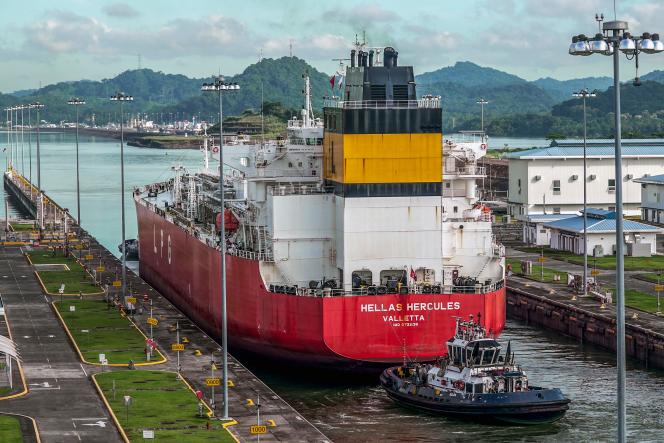This is an unexpected consequence of climate change and the El Niño phenomenon: access to the Panama Canal, the passageway for merchant ships between the Atlantic and the Pacific, will be reduced for a year due to the lack of rain.
Since July 30, the number of vessels allowed each day has been reduced from 40 to 32 and their draft, the height of the submerged part of the boat, has been reduced to 44 feet (13.4 meters). “Today we expect [de prolonger ces mesures] for a year, unless in September, October and November heavy rain falls in the canal catchment area and fills the lakes”told Agence France-Presse (AFP) Ilya Espino, deputy administrator of the channel.
This announcement should enable channel customers to better ” to plan “ their passages, she added. The restrictions have indeed had a spectacular consequence: traffic jams for ships, waiting on both sides of the canal, to be able to cross. There were 130 on Thursday and the total rose to 160 during August.
The waiting time has skyrocketed: previously three to five days, it reached nineteen days to return to eleven today. “We easily manage a queue of 90 ships”, but “130 or 140, that causes us problems and causes delays”acknowledges M.me Espino.
The crisis even prompted the Colombian President, Gustavo Petro, to believe that the canal was closed, which his Panamanian counterpart denied. “We have restrictions in Panama as we have had before, but the canal is not closed, it is not true”Laurentino Cortizo said on Wednesday.
“Exponential consumption”
80 kilometers long, the canal offers direct access between the Caribbean Sea and the Pacific Ocean, which makes it possible to circumvent the South American continent. 6% of world maritime trade passes through it and the main countries that use it are the United States, China and Japan.
Rainwater is currently essential to move ships through the locks (up to 26 meters above sea level), so that they can pass through the continental mountain range of the isthmus. For each boat, it is necessary to discharge about 200 million liters of fresh water, which the canal obtains from a watershed formed by the Gatun and Alajuela lakes. Not only is this basin currently suffering from the lack of rain, but it must continue to supply drinking water to half of the country’s 4.2 million inhabitants.
“We need to find solutions so that we can continue to be a primary route for international trade. If we don’t adapt, we will die.”said the administrator of the channel, Ricaurte Vasquez recently. “At the moment the situation is manageable, but we need to show the industry that we are taking definitive action to resolve the problem” because “there is an exponential consumption”both from humans and from the channel itself, “for which two reservoirs [lacs] were built, explains former channel administrator Jorge Quijano, interviewed by AFP.
For the time being, the reduction in draft results in a reduction in the loading capacity of each ship and therefore in the income that Panama derives from tolls. For 2024, the Canal Authority predicts that the number of tonnes of goods passing through the isthmus will be “less than 500 million”whereas it was 518 million in 2022, which represents a drop in revenue of approximately 200 million dollars, on a turnover which had exceeded 3 billion dollars last year. “It’s a situation that will last a year, so I don’t think it can be worse than what we experienced during the Covid-19 pandemic”estimated Mme Espino.
